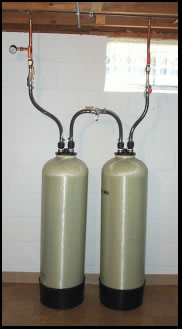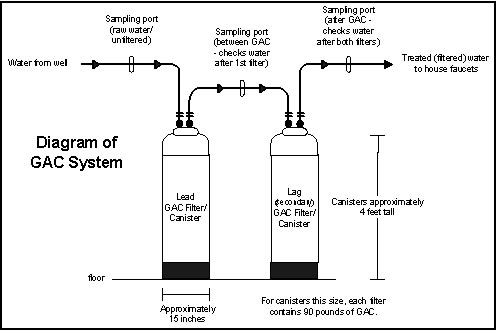Hazardous Sites & Substances
- Hazardous Sites and Substances Home
- Hazardous Waste Sites
- Topics
- Choose Safe Places Minnesota
- Environmental Exposures Grand Rounds
- Exposure and Health Investigations
- Contact us
Related Topics
- Water Contaminants and Your Health
- Cancer and the Environment
- Fish Consumption Guidance
- Children's Environmental Health
- Air Quality by Topic
- MN Public Health Data Access Portal
Environmental Health Division
Contact Info
Water Treatment Using Carbon Filters: GAC Filter Information
A filter with granular activated carbon (GAC) is a proven option to remove certain chemicals, particularly organic chemicals, from water. GAC filters also can be used to remove chemicals that give objectionable odors or tastes to water such as hydrogen sulfide (rotten eggs odor) or chlorine.
However, other chemicals, like iron and nitrate, are not attracted to the carbon and are not removed and another type of filter, such as reverse osmosis (RO) or green sand may be needed. RO filters will also remove certain organic chemicals. This information only addresses GAC filters.
Granular activated carbon is made from raw organic materials (such as coconut shells or coal) that are high in carbon. Heat, in the absence of oxygen, is used to increase (activate) the surface area of the carbon; this is why these filters are sometimes referred to as “charcoal” filters. The activated carbon removes certain chemicals that are dissolved in water passing through a filter containing GAC by trapping (adsorbing) the chemical in the GAC.
It is very important that the type and concentration of contaminants, and average water use, be known in order to determine the correct size and components of the system. All treatment systems require proper installation and periodic maintenance. Eventually, the ability of the GAC to bind and remove chemicals is used up and the GAC needs to be changed. How often the GAC should be changed needs to be based on contaminant levels and water use. While some filters may last for several years if contaminant levels and/or water use are low, higher levels or use may require more frequent change-outs.
There are two types of GAC filter systems:
1. Whole-House Filters or Point of Entry

A whole-house filter is installed at a point on the home's water supply plumbing that will result in treatment of all water that travels to any faucet or fixture in the home (but typically will exclude outside faucets to prolong the life of the carbon). It removes the chemicals before they can be ingested, breathed in, or absorbed by the skin during washing or bathing.
The filters are usually cylindrical in shape. The example shown in the photo is about 4-feet tall and 15 inches in diameter. The filters are usually installed as a pair, although more may be required in some situations. Two filters arranged in sequence ensure that any chemical that might get past the first filter is trapped by the second.
When the first filter is used up, the second filter is moved to the first position and a new filter is placed in the second position. Sample ports located before, between, and after the filters allow for testing of the water at each location (see diagram on the next page).
Most systems also have a bypass switch that allows the water flow to bypass the system when needed for chlorination or certain plumbing activities. When the system is bypassed, the water entering the home is NOT being filtered.

2. Point of Use Filters
A point of use (POU) filter is installed in the water supply pipe just before the faucet where people get water.
One example is an under-sink unit; water passes through the carbon filter and travels to a separate water tap, next to the main faucet. Water from the separate tap will be GAC-treated, and water from the main faucet (hot or cold) will be untreated.
Other examples of point of use filters are the GAC pitcher filters commonly sold in grocery stores or GAC filters that are a part of a refrigerator’s icemaker.
Which system you need depends on:
- The type and amount of contaminants in the water,
- Other chemicals in the water,
- Water use, and
- Exposure pathways that need to be eliminated. (Exposure pathways are the ways that chemicals enter the body.)
Under-Sink Filter
An under-sink filter protects people from ingesting the chemical by treating the drinking or cooking water only from that tap. It will not protect people from inhaling the chemical while showering or bathing, prevent the chemical from being absorbed through the skin, or protect other water faucets. Inhalation is a concern when the chemical easily evaporates from the water into the air. Not all contaminants easily evaporate into the air or are absorbed through the skin.
Whole-House Filter System
A whole-house filter system treats all water traveling to any faucet or fixture in the home. It removes the chemical before it can be ingested, breathed in, or absorbed by the skin during washing or bathing.
- For all work on your filter system, use only a licensed plumber or licensed water conditioning contractor.
- For either type of filter system, consistent maintenance and periodic filter replacement is essential to ensure effectiveness and prevent bacterial build-up.
- It is recommended that water treatment systems be tested and certified to national standards by a reputable testing laboratory, such as NSF.
- The Minnesota Water Quality Association also has information about water treatment systems.
Printable information sheet
Contact us
For more information, please contact us.
This information was prepared in cooperation with the federal Agency for Toxic Substances and Disease Registry (ATSDR). This statement does not imply that ATSDR has endorsed this information sheet.